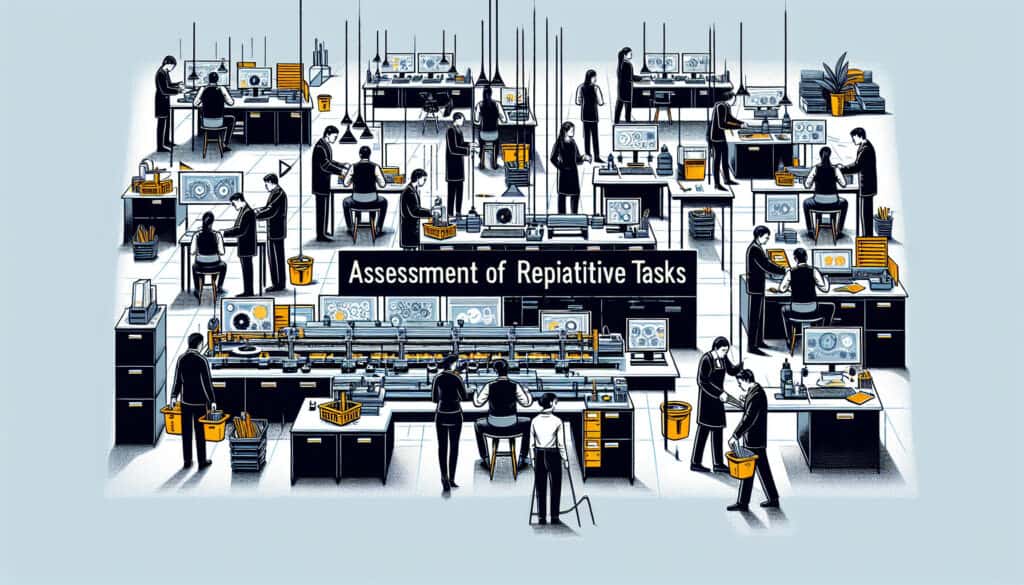Uno strumento sviluppato dall'Health and Safety Executive (HSE) del Regno Unito per aiutare a valutare i rischi derivanti da attività ripetitive.
- Metodologie: Clienti e marketing, Ideazione, Progettazione del prodotto
Valutazione dei compiti ripetitivi (ART)

Valutazione dei compiti ripetitivi (ART)
- Miglioramento continuo, Ergonomia, Fattori umani, Ingegneria dei fattori umani (HFE), Miglioramento dei processi, Gestione della qualità, Analisi del rischio, Gestione del rischio, Sicurezza
Obiettivo:
Come si usa:
- Lo strumento ART è una semplice lista di controllo che aiuta gli utenti a valutare i fattori di rischio associati alle attività ripetitive, come la ripetizione, la forza e la postura. Fornisce un punteggio numerico che può essere utilizzato per dare priorità alle attività ad alto rischio.
Professionisti
- È uno strumento semplice e facile da usare, può essere utilizzato da persone con competenze ergonomiche limitate e fornisce un modo chiaro e semplice per valutare i rischi derivanti da attività ripetitive.
Contro
- È uno strumento di screening e potrebbe non essere sufficiente per una valutazione ergonomica dettagliata, il sistema di punteggio è soggettivo e potrebbe non essere applicabile a tutti i tipi di attività ripetitive.
Categorie:
- Ergonomia, Risorse umane, Gestione del rischio
Ideale per:
- Valutazione dei rischi di disturbi all'arto superiore nelle attività ripetitive.
La metodologia Assessment of Repetitive Tasks (ART) è ampiamente applicabile in settori come la produzione, la logistica, la sanità e le catene di montaggio, dove i movimenti ripetitivi sono prevalenti. Questo strumento è particolarmente utile durante la fase di progettazione di nuovi prodotti o sistemi, dove la comprensione dell'impatto ergonomico sui lavoratori può guidare le modifiche prima dell'implementazione su larga scala. ART aiuta a identificare le mansioni che comportano un rischio maggiore di disturbi agli arti superiori, consentendo ai team di dare priorità agli interventi che riducono tali rischi. I partecipanti a questa valutazione includono in genere ergonomisti, esperti di salute sul lavoro e responsabili di produzione, che possono utilizzare efficacemente la lista di controllo ART anche con conoscenze ergonomiche di base. Il punteggio numerico fornito da ART non solo classifica i compiti in base al rischio, ma facilita anche la comunicazione dei problemi di sicurezza tra le parti interessate al progetto. Casi di studio in linee di assemblaggio automobilistiche hanno dimostrato una significativa riduzione degli infortuni sul lavoro in seguito alle valutazioni di ART, illustrando la sua applicazione pratica in scenari reali. La semplicità di ART lo rende uno strumento accessibile alle organizzazioni che cercano di migliorare l'ergonomia del posto di lavoro senza richiedere una formazione avanzata, rendendolo una risorsa preziosa per le operazioni su piccola e grande scala che mirano a migliorare la sicurezza e la produttività dei lavoratori.
Fasi chiave di questa metodologia
- Identificare ed elencare i compiti ripetitivi svolti.
- Valutare la frequenza di ogni attività in un determinato periodo di tempo.
- Valutare il livello di forza applicato durante i compiti utilizzando misure standard.
- Analizzare la postura assunta durante l'esecuzione del compito, annotando eventuali posizioni scomode.
- Assegnare un punteggio numerico in base ai criteri di valutazione della ripetizione, della forza e della postura.
- Calcolare il punteggio totale per ogni attività per determinare i livelli di rischio.
- Dare priorità alle attività in base ai punteggi di rischio totali per ulteriori azioni o interventi.
Suggerimenti per i professionisti
- Integrate i cicli di feedback nelle vostre valutazioni ART raccogliendo input da coloro che sono direttamente impegnati nelle attività ripetitive; questo può rivelare fattori di rischio trascurati e migliorare l'accuratezza.
- Utilizzare il sistema di punteggio ART per guidare i processi di miglioramento continuo, garantendo che le attività ad alto rischio siano prioritarie per l'intervento e monitorate nel tempo per valutare l'efficacia dei cambiamenti implementati.
- Combinare la valutazione ART con metodi osservazionali e strumenti ergonomici aggiuntivi, creando un approccio completo che affronti i fattori di rischio sia qualitativi che quantitativi per migliorare le strategie di intervento.
Leggere e confrontare diverse metodologie, raccomandiamo il
> Ampio archivio di metodologie <
insieme ad altre 400 metodologie.
I vostri commenti su questa metodologia o ulteriori informazioni sono benvenuti su sezione commenti qui sotto ↓ , così come tutte le idee o i link relativi all'ingegneria.
Contesto storico
1986
(se la data non è nota o non è rilevante, ad esempio "meccanica dei fluidi", viene fornita una stima approssimativa della sua notevole comparsa)

Post correlati
Calcolatore da METS a calorie
Meta-analisi
Mappatura dei messaggi
Diagrammi del modello mentale
Forze di spinta e di trazione massime accettabili
Pianificazione dei fabbisogni di materiale (MRP)